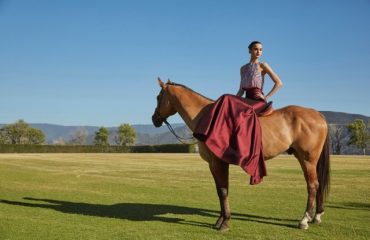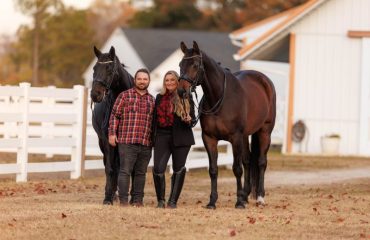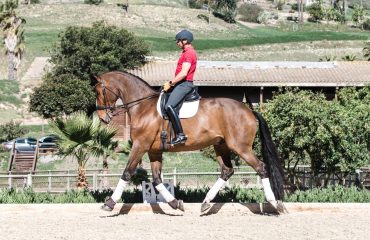By Britney Grover
Saly Glassman was predestined to a life with horses from the time her father clambered into the milk man’s cart at age 3 and drove the horse away. She grew up foxhunting and showing alongside her father, and kept horses in her life throughout her 39-year career in finance at Merrill Lynch. So when Saly was offered the opportunity to pass her practice on to her protégés, she took it to start an equine-related charity in Blue Bell, Pennsylvania, just outside of Philadelphia. 
Knowing she wanted to do something combining her passion for horses, her training in psychology and her innate desire to help people, Saly had already acquired nonprofit status for Kindle Hill Foundation when the COVID-19 pandemic hit. She asked herself who really needed her help; healthcare workers were untouchable, quarantined, and teachers were at home teaching virtually.
“And then I thought about the first responder community — they didn’t have a choice at all,” Saly said. “They weren’t at the risk of sickness in the same way that the healthcare community was, but the first responder community was in a high level of danger, with the violence from aggression and the controversy around police.”
Saly believes there’s a disconnect in the public’s understanding of what it means to be in the first responder community and the pressure society exerts with myopic criticism, publicizing mostly negative incidents. “To me, it was like a giant misunderstanding — people who have devoted their lives to serve us should not be grouped as one entity, and treated in a disrespectful way, with a complete lack of sympathy and understanding,” she said. “The fact is that they are so good at what they do, they’re actually invisible.”
Without existing programs to incorporate, Saly called the local chief of police, Kenneth Lawson of Whitpain Township, and asked him to help her develop curriculum for an equine-assisted learning program aimed at first responders, and to recruit the first participants. But Saly didn’t just want to get the program started — she wanted to prove it worked. “Give me one or two people who are not so cooperative, who are stubborn and say, ‘I’m not doing that horse thing,’ and just get them to do it,” Saly asked Chief Lawson. “Once I change their minds, other people will want to do it.”
Successful Self-Care
And so they did. To date, hundreds of first responders have gone through the Kindle Hill program, with four two-hour sessions limited to a small number of participants. The community has rallied to support the program, and the benefits reach far beyond each first responder.
On the most basic level, every session of the program offers the welcome relief of total focus on the relationship and interactions with a horse: two valuable hours where an officer doesn’t have to think about work. In the program, responders learn everything from leading to round-penning with curriculum tailored to help them both personally and professionally. Teaching improved self-care, recognition of trauma and PTSD, and that there’s no shame in getting proper help, is the first set of goals at Kindle Hill.
On the protected 128-acre farm at Kindle Hill, there are between five and seven of what Saly calls “professional” equine-assisted learning and equine-assisted therapy horses. Those particularly compassionate, sympathetic and experienced horses are often used with the first responders, but if they’re busy, Saly enlists the help of her five show jumpers. A horse doesn’t need special training to bring unique value to the program: Horses have much in common with first responders and offer life-changing lessons.
“What first responders really appreciate about horses is that they’re never ‘off-duty,’” Saly explained. “If you’re a horse, as a prey animal, you can never just abandon everything and say, ‘I’m not going to worry about my next few minutes.’ It would be irresponsible, and there would be something wrong with you. As soon as officers learn that another animal sees the world through their eyes, they realize, ‘I am not alone. Someone else understands my life.’”
Those familiar with the culture might be used to the “hypervigilance rollercoaster” where first responders are so mentally, emotionally and physically invested at work — with heightened reactions, awareness and stress — that when their shift ends, they have to “check out” and swing to a low, depressive state. Done repetitively, without proper self-care, this rollercoaster has devastating long-term physical effects on an individual, and can have dire consequences for relationships.
Because horses are programmed not to “check out” for very long, they utilize other methods of conserving energy that can help first responders learn to even out the rollercoaster a bit — like processing emotions expediently rather than stuffing them down into an internal pile that inevitably grows and creates cumulative problems. “Horses don’t have time for that,” Saly said. “They might have a disagreement with another horse, and then they move on. We can learn from something as simple as that.”
New Tools
After teaching self-care and more effective strategies for negotiating in life, the second goal of the program is to teach de-escalation, collaboration and partnership techniques — that there are alternatives to what might be a “go to” physical response. Participants have related that the program has caused them to rethink some things, to be less quick to judge and more open-minded, watching for nonverbal clues that indicate there may be more going on than meets the eye in a situation.
Unlike those accustomed to being around horses, the general public — including first responders — may be apprehensive about approaching a horse. “One of the first things they have to overcome is the initial sensation of, ‘Oh my goodness, these things are really big; they could really hurt me, and I’m really scared,’” Saly shared. “But I think that’s good, because how do you feel when you’re driving down the road at what you think is the speed limit and you get pulled over? There’s inherent fear. When officers first come into the class and they’re afraid, they suddenly realize how a person might feel when they’re approached by someone in a uniform. It helps for them to feel what we feel — just like we need to feel what they feel.”
Through exercises with a horse, first responders learn how to be non-predatory and assess how the other party is receiving their approach, such as varying amounts of pressure and release to reward a desired behavior. Learning to read non-verbal cues on a horse can translate into reading non-verbal cues with humans in an intense situation. All of the interactions are designed to give first responders more tools and ways to do just that: respond.
With her husband, Ira, professional counselor Sean Homsher, equine specialist Leslie Molinari and the rest of the Kindle Hill Foundation team, Saly hopes to reach as many first responders as they can. A larger goal is to help the community have a better understanding of the sacrifices made and the work done by first responders, to revisit the inclination to judge harshly those who are committed to serve and protect.
“We shouldn’t be so dismissive and willing to paint with a broad brush police officers and firefighters as this or that — it’s unfair to group any faction under one label. You wouldn’t want it done to you, so let’s not do it — and let’s be more sensitive to what we’re getting from the people who protect us: a lot,” Saly said. “I think we need to better recognize the dedication and commitment that first responders provide — and we need to support them and have their backs.”
For more information, visit kindlehill.org
Photos by Du Soleil Photographie













